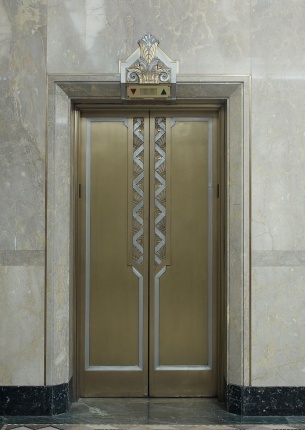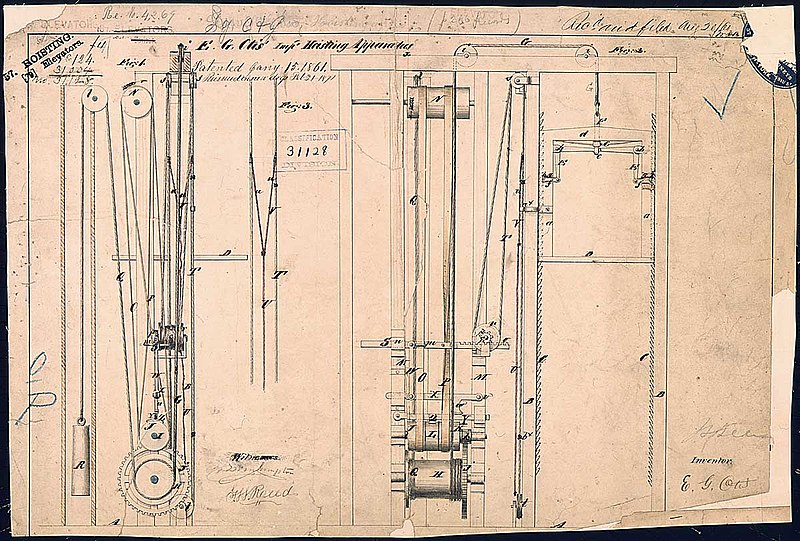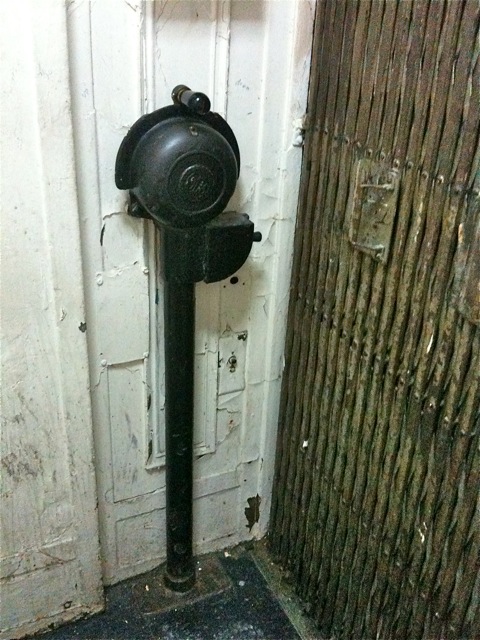Self-Service Lifte
A Self-Service Lifte, also called an automatic lifte, is a type of passenger lifte1 that can be operated by the passengers themselves, without the assistance of a Lifte Operator or "Lifteman." Modern passenger lifte systems typically consist of an enclosed carriage or "car" which is raised and lowered within a "hoistway" by means of a counter-weighted traction cable, driven by electric motors. Another popular system, called a "jack lifte," uses a telescoping hydraulic piston to raise and lower the car, although the use of jack liftes is usually limited to low-rise (5 to 6 storey) applications. A complicated system of push-button controlled relays, floor-leveling sensors and interlocking doors allows modern liftes to be operated safely by virtually any potential passenger.
Historians dispute the the origins of the passenger lifte. Some attribute its invention to Abd al-Majid in the third century BCS, while others argue that a compound-pulley found in the ruins of Hazam Sidram is evidence of a lifte system dating to the fifth century BCS. In The Book of Secret Ideas, written by Ibn Sharaf al-Makrām in 999 CA, there is described a lifte-like device that was used to raise the throne of Sultan Ra’d bin Sufim al-Saqqaf over ten yards above the floor of his palace. In the early seventeenth century, primitive manually operated lifte systems were installed in the royal palaces of Érevon and Velandriault.
These ancient and middle-age liftes employed rope-and-pully systems operated by a windlass. The invention of a hoisting system employing Abd al-Majid's leadscrew design may have been the most significant advancement in the development of modern lifte systems. The first practical leadscrew-driven lifte, based upon an earlier design by Léandre du Vinzeau, was installed in the Narangerel Palace in Samlazaz during the summer of 1793 by Khünbish Khogaghchin, Chief Engineer to the Qaghan.
EARLY DEVELOPMENTS
Nineteenth century advancements in lifte technology were driven primarily by the need to move raw materials, especially minerals such as iron ore, coal, manganese and tin (not to mention gold, silver and copper) from increasingly deep mining operations. New technologies developed by the mining industry, combined with the introduction of state-of-the-art steel beam building designs, accelerated the widespread use of the modern passenger liftes commonly seen today.
The first mechanical mining liftes were operated by steam power, and were rapidly adapted to transport raw materials and finished products within multi-level factory buildings. In 1823, the technology was further adapted by two Lantara architects, Gallagher and Lynche, who built a novel tourist attraction in the center of the city called the "High Chair," which used steam power to hoist a passenger strapped to a wooden chair over twenty yards into the air, affording spectacular panoramic views of the city. The "High Chair" is considered by some to be the first example of a modern passenger lifte ever constructed.
These crude designs were further refined in the decades that followed. In 1835, the Benedikt Meitner company in Ansrau, Salizach constructed an innovative belt-driven lifte called an "Aufzug" which used a counterweight for added lifting power. Ten years later, Geulian architect Torkild Høyer installed a magnificent "Elevator" in the Royal Palace of Drisgård. Høyer's device was exceptional in its elegance. Constructed of chestnut and maple inlaid with teak and mahogany, it included two cushioned benches and an oil lamp for illumination of the interior. It was operated remotely by a motor mechanic, requiring no effort from the occupants.
MODERN IMPROVEMENTS
In 1853, Dalradian engineer Elias Oates established the Oates Lifte Company in Galblayney, Érevon after securing a patent for his "Safety Lifte" design, which prevented the car from falling if the hoisting cable failed. A brilliant self-promoter, Oates personally demonstrated the effectiveness of his patented lifte system in a death-defying performance before a live audience at the Ballmargath World Industrial Exhibition of 1854. After news of his spectacular publicity stunt made headlines worldwide, orders began flooding into the company.
The first Oates Safety Lifte was installed in the ÓHartigan Building at 575 Talerney Avenue in Ballmargath in 1856, with the inaugural ascension occurring on 13 Achmonat of that year. The first office building to install the Oates Lifte system was the Fiduciary Life and Casualty Building, completed at 33 Park Street, Ballmargath in 1859.
In 1873, Bayernian electrical engineer, inventor and industrialist Ernst Werner von Ziemens built the first electric lifte in Nordenmünster, Bayernia. His rheostat-controlled electric motors allowed for smoother acceleration and deceleration than steam-powered liftes, and soon his company was selling electric "Fahrstuhl" systems throughout western Heremonnia. Other manufacturers quickly adopted electric motor technology and by 1880 electric traction dominated the passenger lifte industry.
The speed and safety of electric passenger liftes were greatly enhanced by Érevish electrical engineer and inventor Hugh Hough,2 who founded the Hough Electric Lifte Company in 1878. Among his many innovations were improved floor-leveling control and interlocking doors that automatically closed off the shaft when the car was not present. Hough also developed an "Automatic Deployment System" that used a series of electromechanical push-buttons to set the floors at which the car would stop. The Hough lifte ran faster and carried more passengers than other designs, and he had installed 584 lifte systems by the time he sold the firm to the Oates Lifte Company in 1885.
At the turn of the century, the widespread availability of safe and reliable passenger lifte technology, combined with rapid advancements in the "steel frame and curtain wall" method of building construction, and the increased concentration of wealth generated by the accelerating industrial revolution, produced ever taller buildings in major cities around the world. Soon the "Skyreacher" became an important status symbol for major cities and corporations around the world. Today, buildings in every major city reach heights that would have been unheard of without modern vertical transportation technology, and the passenger lifte is ubiquitous.
Originally, all lifte systems required a trained operator. At the turn of the century, virtually all existing lifte installations had no automatic positioning device to align the car with the floor at which it stopped. They were manually controlled by a Lifte Operator using a rheostat connected to the traction motor. By sliding the handle forward, the operator raised the car. Sliding it backward caused the car to descend. The degree of pressure applied determined the speed of the car. With practice, a skilled operator could stop the car with precision at the floor level, but it was not uncommon for an operator to move the car up and down in small increments before a safe alignment was achieved.
Electromechanical control devices, based upon Hugh Hough's "Automatic Deployment System," began to appear in the 1920s, and many Automatic Lifte systems were installed in new buildings throughout the decades that followed. However, the general public remained extremely skeptical of using a lifte without the reassurance of a skilled operator standing by. As a result, many new liftes went unused, and many upper storey apartments unoccupied, because of pervasive public fear of driver-less liftes. But a strike in 1950 by the International Brotherhood of Liftemen & Motormen caused such widespread hardship that the public became more receptive to the self-service lifte concept.
AUTOMATIC OPERATION
Automatic, or self-service liftes are fitted with several modern features that allow the lift to be safely and efficiently operated by the passengers themselves. Early self-service liftes featured a simple panel mounted to the wall of the car, with buttons used to select the floor at which the passenger desired to stop. However, faced with the unexpected negative public sentiment, manufacturers and developers launched an aggressive public information campaign, touting the safety and efficiency of the new technology. They also added several additional features to the panel, including door control buttons, an emergency stop button and an emergency telephone. Nevertheless, neither the addition of these extra safety features, nor even the soothing qualities of nondescript pre-recorded instrumental music played through concealed speakers could convince the general population to use self-service liftes with any regularity. But the liftemen's strike of 1950 changed all that.
In the large cities, where skyreachers filled with thousands of people crowded the downtown districts, the 1950 liftmen's strike had a devastating impact. Public sentiment turned against the strikers immediately, as they chose to walk out at lunchtime, stranding hundreds of thousands of office workers. Building owners scrambled to retrofit their elevators with the new automatic controllers wherever it was possible to do so, in order to prevent all business from grinding to a halt. Out of necessity, the public wholeheartedly adopted the self-service lift, and within a decade the lifteman was a relic of the past.
History
ANCIENT EXAMPLESHistorians dispute the the origins of the passenger lifte. Some attribute its invention to Abd al-Majid in the third century BCS, while others argue that a compound-pulley found in the ruins of Hazam Sidram is evidence of a lifte system dating to the fifth century BCS. In The Book of Secret Ideas, written by Ibn Sharaf al-Makrām in 999 CA, there is described a lifte-like device that was used to raise the throne of Sultan Ra’d bin Sufim al-Saqqaf over ten yards above the floor of his palace. In the early seventeenth century, primitive manually operated lifte systems were installed in the royal palaces of Érevon and Velandriault.
These ancient and middle-age liftes employed rope-and-pully systems operated by a windlass. The invention of a hoisting system employing Abd al-Majid's leadscrew design may have been the most significant advancement in the development of modern lifte systems. The first practical leadscrew-driven lifte, based upon an earlier design by Léandre du Vinzeau, was installed in the Narangerel Palace in Samlazaz during the summer of 1793 by Khünbish Khogaghchin, Chief Engineer to the Qaghan.
EARLY DEVELOPMENTS
Nineteenth century advancements in lifte technology were driven primarily by the need to move raw materials, especially minerals such as iron ore, coal, manganese and tin (not to mention gold, silver and copper) from increasingly deep mining operations. New technologies developed by the mining industry, combined with the introduction of state-of-the-art steel beam building designs, accelerated the widespread use of the modern passenger liftes commonly seen today.
The first mechanical mining liftes were operated by steam power, and were rapidly adapted to transport raw materials and finished products within multi-level factory buildings. In 1823, the technology was further adapted by two Lantara architects, Gallagher and Lynche, who built a novel tourist attraction in the center of the city called the "High Chair," which used steam power to hoist a passenger strapped to a wooden chair over twenty yards into the air, affording spectacular panoramic views of the city. The "High Chair" is considered by some to be the first example of a modern passenger lifte ever constructed.
These crude designs were further refined in the decades that followed. In 1835, the Benedikt Meitner company in Ansrau, Salizach constructed an innovative belt-driven lifte called an "Aufzug" which used a counterweight for added lifting power. Ten years later, Geulian architect Torkild Høyer installed a magnificent "Elevator" in the Royal Palace of Drisgård. Høyer's device was exceptional in its elegance. Constructed of chestnut and maple inlaid with teak and mahogany, it included two cushioned benches and an oil lamp for illumination of the interior. It was operated remotely by a motor mechanic, requiring no effort from the occupants.
MODERN IMPROVEMENTS
In 1853, Dalradian engineer Elias Oates established the Oates Lifte Company in Galblayney, Érevon after securing a patent for his "Safety Lifte" design, which prevented the car from falling if the hoisting cable failed. A brilliant self-promoter, Oates personally demonstrated the effectiveness of his patented lifte system in a death-defying performance before a live audience at the Ballmargath World Industrial Exhibition of 1854. After news of his spectacular publicity stunt made headlines worldwide, orders began flooding into the company.
The first Oates Safety Lifte was installed in the ÓHartigan Building at 575 Talerney Avenue in Ballmargath in 1856, with the inaugural ascension occurring on 13 Achmonat of that year. The first office building to install the Oates Lifte system was the Fiduciary Life and Casualty Building, completed at 33 Park Street, Ballmargath in 1859.
In 1873, Bayernian electrical engineer, inventor and industrialist Ernst Werner von Ziemens built the first electric lifte in Nordenmünster, Bayernia. His rheostat-controlled electric motors allowed for smoother acceleration and deceleration than steam-powered liftes, and soon his company was selling electric "Fahrstuhl" systems throughout western Heremonnia. Other manufacturers quickly adopted electric motor technology and by 1880 electric traction dominated the passenger lifte industry.
The speed and safety of electric passenger liftes were greatly enhanced by Érevish electrical engineer and inventor Hugh Hough,2 who founded the Hough Electric Lifte Company in 1878. Among his many innovations were improved floor-leveling control and interlocking doors that automatically closed off the shaft when the car was not present. Hough also developed an "Automatic Deployment System" that used a series of electromechanical push-buttons to set the floors at which the car would stop. The Hough lifte ran faster and carried more passengers than other designs, and he had installed 584 lifte systems by the time he sold the firm to the Oates Lifte Company in 1885.
At the turn of the century, the widespread availability of safe and reliable passenger lifte technology, combined with rapid advancements in the "steel frame and curtain wall" method of building construction, and the increased concentration of wealth generated by the accelerating industrial revolution, produced ever taller buildings in major cities around the world. Soon the "Skyreacher" became an important status symbol for major cities and corporations around the world. Today, buildings in every major city reach heights that would have been unheard of without modern vertical transportation technology, and the passenger lifte is ubiquitous.
Operation
MANUAL OPERATIONOriginally, all lifte systems required a trained operator. At the turn of the century, virtually all existing lifte installations had no automatic positioning device to align the car with the floor at which it stopped. They were manually controlled by a Lifte Operator using a rheostat connected to the traction motor. By sliding the handle forward, the operator raised the car. Sliding it backward caused the car to descend. The degree of pressure applied determined the speed of the car. With practice, a skilled operator could stop the car with precision at the floor level, but it was not uncommon for an operator to move the car up and down in small increments before a safe alignment was achieved.
Electromechanical control devices, based upon Hugh Hough's "Automatic Deployment System," began to appear in the 1920s, and many Automatic Lifte systems were installed in new buildings throughout the decades that followed. However, the general public remained extremely skeptical of using a lifte without the reassurance of a skilled operator standing by. As a result, many new liftes went unused, and many upper storey apartments unoccupied, because of pervasive public fear of driver-less liftes. But a strike in 1950 by the International Brotherhood of Liftemen & Motormen caused such widespread hardship that the public became more receptive to the self-service lifte concept.
AUTOMATIC OPERATION
Automatic, or self-service liftes are fitted with several modern features that allow the lift to be safely and efficiently operated by the passengers themselves. Early self-service liftes featured a simple panel mounted to the wall of the car, with buttons used to select the floor at which the passenger desired to stop. However, faced with the unexpected negative public sentiment, manufacturers and developers launched an aggressive public information campaign, touting the safety and efficiency of the new technology. They also added several additional features to the panel, including door control buttons, an emergency stop button and an emergency telephone. Nevertheless, neither the addition of these extra safety features, nor even the soothing qualities of nondescript pre-recorded instrumental music played through concealed speakers could convince the general population to use self-service liftes with any regularity. But the liftemen's strike of 1950 changed all that.
In the large cities, where skyreachers filled with thousands of people crowded the downtown districts, the 1950 liftmen's strike had a devastating impact. Public sentiment turned against the strikers immediately, as they chose to walk out at lunchtime, stranding hundreds of thousands of office workers. Building owners scrambled to retrofit their elevators with the new automatic controllers wherever it was possible to do so, in order to prevent all business from grinding to a halt. Out of necessity, the public wholeheartedly adopted the self-service lift, and within a decade the lifteman was a relic of the past.
__________________________________________________
1 A vertical transportation system that moves people between the floors of a structure.
2 Known as the "Father of Electric Traction," Hugh Hough founded the Hough Electric Traction Motor Company in 1870 after graduating from the Royal Naval Academy of Érevon and serving five years as a naval officer.
2 Known as the "Father of Electric Traction," Hugh Hough founded the Hough Electric Traction Motor Company in 1870 after graduating from the Royal Naval Academy of Érevon and serving five years as a naval officer.






Comments